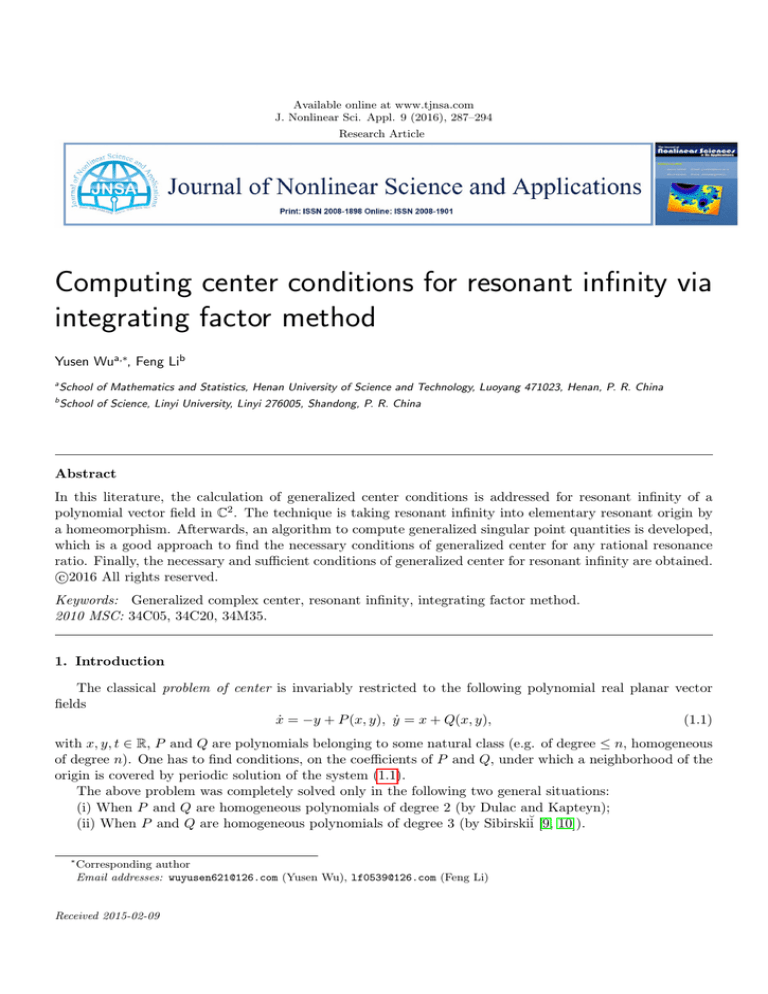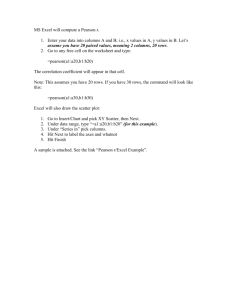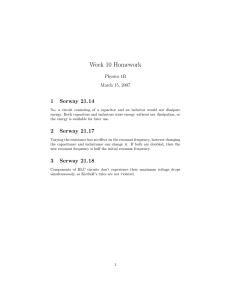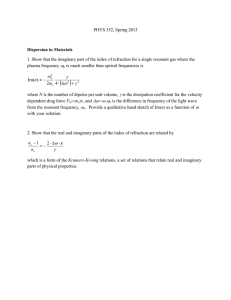
Available online at www.tjnsa.com
J. Nonlinear Sci. Appl. 9 (2016), 287–294
Research Article
Computing center conditions for resonant infinity via
integrating factor method
Yusen Wua,∗, Feng Lib
a
School of Mathematics and Statistics, Henan University of Science and Technology, Luoyang 471023, Henan, P. R. China
b
School of Science, Linyi University, Linyi 276005, Shandong, P. R. China
Abstract
In this literature, the calculation of generalized center conditions is addressed for resonant infinity of a
polynomial vector field in C2 . The technique is taking resonant infinity into elementary resonant origin by
a homeomorphism. Afterwards, an algorithm to compute generalized singular point quantities is developed,
which is a good approach to find the necessary conditions of generalized center for any rational resonance
ratio. Finally, the necessary and sufficient conditions of generalized center for resonant infinity are obtained.
c
2016
All rights reserved.
Keywords: Generalized complex center, resonant infinity, integrating factor method.
2010 MSC: 34C05, 34C20, 34M35.
1. Introduction
The classical problem of center is invariably restricted to the following polynomial real planar vector
fields
ẋ = −y + P (x, y), ẏ = x + Q(x, y),
(1.1)
with x, y, t ∈ R, P and Q are polynomials belonging to some natural class (e.g. of degree ≤ n, homogeneous
of degree n). One has to find conditions, on the coefficients of P and Q, under which a neighborhood of the
origin is covered by periodic solution of the system (1.1).
The above problem was completely solved only in the following two general situations:
(i) When P and Q are homogeneous polynomials of degree 2 (by Dulac and Kapteyn);
(ii) When P and Q are homogeneous polynomials of degree 3 (by Sibirskiĭ [9, 10]).
∗
Corresponding author
Email addresses: wuyusen621@126.com (Yusen Wu), lf0539@126.com (Feng Li)
Received 2015-02-09
Y. Wu, F. Li, J. Nonlinear Sci. Appl. 9 (2016), 287–294
288
The mentioned center problem is the subject of much work (see monographs [5, 13]), here we do not cite
many more concrete literatures.
When we treat (1.1) as a system in the complex plane (with complex time), then after a simple change
of variable it is equivalent to
ẋ = x + · · · , ẏ = −y + · · · ,
(1.2)
i.e. to a 1 : −1 resonant saddle. The existence of a center is equivalent to the existence of a local analytic
first integral of the form H = xy +· · · (Equivalent condition: absence of the resonant terms (xy)k (x∂x +y∂y )
in the normal form).
On the other hand, to our notice, a natural generalization of the center problem is proposed in [14] to
consider the case of a polynomial vector field in C2 with p : −q resonant elementary singular point
ẋ = px + P (x, y), ẏ = −qy + Q(x, y),
(1.3)
with p, q ∈ Z+ . The only way to get necessary conditions for a center is to compute the p : −q resonant
focus numbers, the analogues of the Poincaré-Lyapunov focus quantities. If p and q coprimes, then one can
calculate the successive terms in the Taylor expansion of the supposed first integral and the p : −q resonant
focus numbers gk are the coefficients of the obstacles to its existence:
X
gk (xq y p )k+1 .
(1.4)
H = xq y p + · · · , Ḣ =
The gk0 s are polynomials in the coefficients of the system and can be calculated algorithmically.
Looking for conditions for the existence of a local analytic first integral H = xq y p + · · · (i.e. for the
existence of a p : −q resonant center) for system (1.3) has stimulated a great deal of effort from then on.
Equivalent condition for the mentioned problem is the absence of the resonant terms (xq y p )k (px∂x + qy∂y )
in the normal form. For the 1 : −2 resonant singular point the integrability problem is completely solved in
[3, 14] where necessary and sufficient conditions (20 cases) are given. Lotka-Volterra systems of the form
ẋ = x + ax2 + bxy, ẏ = −λy + cxy + dy 2 (λ > 0)
(1.5)
is sufficiently general to give important information on the organization of strata in families of polynomial
systems. One can find parameters such that system (1.5) is normalizable, normalizable but not integrable,
integrable but not linearizable. Necessary and sufficient conditions for integrability and linearizability are
already known in [2, 14] for the case λ ∈ N, that is the 1 : −n resonant cases. In [4], some sufficient
conditions are given in the case of general λ. For the case λ = p2 or p2 , p ∈ N+ , necessary and sufficient
conditions for integrable and linearizable systems are given. They have proven that, in the case λ = p2 or
2
+
p , p ∈ N , if a = d = 0, bc 6= 0 then system (1.5) is integrable but not linearizable, and raised the question
for general rational λ, other open problems are also suggested. In [6], some sufficient conditions for the
systems (1.5) with 3 : −q resonance were given, and the integrability of the particular cases of 3 : −4 and
3 : −5 resonances were investigated.
Y. Wu and C. Zhang ([11]) explored the problems of generalized center conditions and integrability of
resonant infinity for the following complex polynomial differential system
2n
P
dz
dT
= pz n+1 wn +
dw
dT
= −qwn+1 z n −
aαβ z α wβ ,
α+β=0
2n
P
(1.6)
bαβ wα z β ,
α+β=0
where z, w, T, aαβ , bαβ ∈ C, p, q ∈ Z+ , (p, q) = 1, n ∈ N. A new recursive algorithm for computing generalized
singular point quantities at resonant singular point was derived. Compared with the above results, by using
the method of integrating factor method, we develop a parallel recursive algorithm to the calculation of
generalized singular point quantities at resonant infinity in this paper.
Y. Wu, F. Li, J. Nonlinear Sci. Appl. 9 (2016), 287–294
289
The organization of this paper is as follows. Sec. 2 is a section of generalities: we give the definitions
of generalized singular point quantity, generalized complex center, algebraic equivalence, etc., which we will
use in this paper. In Sec. 3 we state and prove the main result. In Sec. 4, as for the experimental part of
our study, we specialize to a class of cubic systems and discuss the conditions under which resonant infinity
can be a generalized complex center.
2. Generalized singular point quantity and integrability
First of all, we need to clarify the main notation as well as the definitions, lemmas and theorems.
Consider the complex polynomial differential system with the form
∞
P
dz
dT
= pz +
dw
dT
= −qw −
aαβ z α wβ = Z(z, w),
α+β=2
∞
P
(2.1)
bαβ wα z β = −W (z, w).
α+β=2
Lemma 2.1 ([1, 4]). For system (2.1), we can derive uniquely the following formal series
∞
X
ξ=z+
ckj z k wj , η = w +
k+j=2
∞
X
dkj wk z j ,
(2.2)
k+j=2
where p0 = q0 = 1, ck+1,k = dk+1,k = 0, k = 1, 2, · · · , such that system (2.1) can be transformed into its
normal form
∞
∞
X
X
dη
dξ
= pξ
pi (ξ q η p )i ,
= −qη
qi (ξ q η p )i .
(2.3)
dT
dT
i=0
i=0
Definition 2.2. For system (2.1), the quantity µk = pk − qk is called the generalized singular point quantity
of order k of the origin. If µ1 = µ2 = · · · = µk−1 = 0, µk 6= 0, then the origin is called a fine singular point
of order k. If for all k, µk = 0, then the origin is called a generalized complex center.
Remark 2.3. If system (2.1) is a real system, then ”µk ” defined in Definition 2.2 is ”the saddle quantity of
order k” defined in [14].
Lemma 2.4 ([12]). The origin of system (2.1) is a generalized complex center if and only if system (2.1)
has a regular first integral at the origin.
Definition 2.5 ([7]). For system (1.6)p=q=1 and any positive integer k, if there exist ζ1 , ζ2 , · · · , ζk−1 which
are polynomials in aαβ , bαβ , such that
µk + ζ1 µ1 + ζ2 µ2 + · · · + ζk−1 µk−1 = λk ,
(2.4)
we say that µk and λk are algebraic equivalence denoted by µk ∼ λk .
Lemma 2.6 ([8]). For system (2.1), we can derive successively the following formal series
M (z, w) =
∞
X
cαβ z α wβ = z q−1 wp−1 + h.o.t.,
(2.5)
α+β=p+q−2
where ckq,kp = 0, k = 1, 2, 3, · · · , h.o.t. stands for high order terms, such that
∞
X
∂(M Z) ∂(M W )
q−1 p−1
−
=z w
(m + 1)λm (z q wp )m .
∂z
∂w
(2.6)
m=1
If λ1 = λ2 = · · · = λm−1 = 0, λm =
6 0, then µ1 = µ2 = · · · = µm−1 = 0, µm 6= 0, and λm ∼ pqµm , m =
1, 2, · · · , where ” ∼ ” is the symbol of algebraic equivalence.
Y. Wu, F. Li, J. Nonlinear Sci. Appl. 9 (2016), 287–294
290
Theorem 2.7 ([11]). Infinity of system (1.6) is a generalized complex center if and only if there exist a
non-zero real number s and a first integral
G(z, w) = (z −q w−p )s
∞
X
g(2n+1)k (z, w)
k=0
(zw)(n+1)k
.
(2.7)
3. The algorithm
By means of transformation
z=
z1
w1
, w=
, dT = (2n + 1)(z1 w1 )n(2n+1) dT1
(z1 w1 )n+1
(z1 w1 )n+1
(3.1)
and renaming (z1 , w1 , T1 ) by (z, w, T ), system (1.6) is brought to
2n
P
dz
dT
= p∗ z +
dw
dT
= −q ∗ w −
e w),
[naαβ + (n + 1)bβ+1,α−1 ]z α+1 wβ+1 (zw)(2n−α−β)(n+1) = Z(z,
α+β=0
2n
P
(3.2)
f (z, w),
[nbαβ + (n + 1)aβ+1,α−1 ]wα+1 z β+1 (zw)(2n−α−β)(n+1) = −W
α+β=0
where
p∗ = np + (n + 1)q, q ∗ = nq + (n + 1)p.
(3.3)
Accordingly, infinity of system (1.6) becomes the origin of system (3.2). Note that transformation (3.1) is a
homeomorphism, thus the study of infinity of system (1.6) is equivalent to the study of the origin of system
(3.2). The origin is an elementary p∗ : −q ∗ resonant singular point of system (3.2).
Remark 3.1. For system (3.2), the functions on the right hand side have the following peculiarities:
(i) There exist two complex straight line solutions z = 0 and w = 0.
(ii) The degree of every monomial higher than one is (2n + 1 − α − β)(2n + 1) + 1, α + β = 0, 1, · · · , 2n.
From Lemma 2.6, we have
Theorem 3.2. For system (3.2), we can derive successively the following formal series
∞
X
f(z, w) =
M
e
cαβ z α wβ = z q
∗ −1
∗ −1
wp
+ h.o.t.,
(3.4)
α+β=p∗ +q ∗ −2
where e
ckq∗ ,kp∗ = 0, k = 1, 2, 3, · · · , such that
∞
X
fZ)
e
fW
f)
∂(M
∂(M
q ∗ −1 p∗ −1
em (z q∗ wp∗ )m ,
−
=z
w
(m + 1)λ
∂z
∂w
(3.5)
m=1
em ∼ p∗ q ∗ µm , m = 1, 2, · · · .
and λ
em above are determined as follows: for ∀(α, β), when p∗ (α + 1) = q ∗ (β + 1),
The coefficients e
cαβ and λ
∗
e
cαβ are arbitrary; when p (α + 1) 6= q ∗ (β + 1),
e
cαβ
2n+1
X
1
{[nα − (n + 1)β − 1]ak,j−1 − [nβ − (n + 1)α − 1]bj,k−1 }
= ∗
q (β + 1) − p∗ (α + 1)
k+j=1
(3.6)
×e
cα+nk+(n+1)j−(2n+1)(n+1),β+nj+(n+1)k−(2n+1)(n+1) .
For any positive integer m,
em = (2n + 1)
λ
2n+1
X
(pbj,k−1 − qak,j−1 )e
cq∗ (m+1)+nk+(n+1)j−(2n2 +3n+2),p∗ (m+1)+nj+(n+1)k−(2n2 +3n+2) .
k+j=1
(3.7)
Y. Wu, F. Li, J. Nonlinear Sci. Appl. 9 (2016), 287–294
In expressions (3.6) and (3.7), for p∗ + q ∗ − 2 ≤ α + β ≤ p∗ + q ∗ + 2n − 2, we have already let
1, α = q ∗ − 1, β = p∗ − 1,
e
cαβ =
0, f or other (α, β)
291
(3.8)
and if α < 0 or β < 0, let aαβ = bαβ = e
cαβ = 0.
Proof. System (3.2) can also be expressed as
2n+1
X
dz
e w),
= p∗ z +
[nak,j−1 + (n + 1)bj,k−1 ]z k+1+(2n+1−k−j)(n+1) wj+(2n+1−k−j)(n+1) = Z(z,
dT
k+j=1
2n+1
X
dw
f (z, w).
= −q ∗ w −
[nbj,k−1 + (n + 1)ak,j−1 ]z k+(2n+1−k−j)(n+1) wj+1+(2n+1−k−j)(n+1) = −W
dT
(3.9)
k+j=1
fZ
e and M
fW
f with respect to z and w, we have
Taking partial derivative of M
f
e
fZ)
e
fW
f)
f
f
∂(M
∂(M
∂M
e − ∂M W
f ) + ( ∂ Z − ∂ W )M
f
Z
−
=(
∂z
∂w
∂z
∂w
∂z
∂w
2n+1
∞
X
X
α−1 β ∗
[nak,j−1 + (n + 1)bj,k−1 ]
αe
cαβ z
w {p z +
=
α+β=p∗ +q ∗ −2
k+j=1
× z k+1+(2n+1−k−j)(n+1) wj+(2n+1−k−j)(n+1) }
−
∞
X
βe
cαβ z α wβ−1 {q ∗ w +
α+β=p∗ +q ∗ −2
2n+1
X
[nbj,k−1 + (n + 1)ak,j−1 ]
k+j=1
× z k+(2n+1−k−j)(n+1) wj+1+(2n+1−k−j)(n+1) }
+
∞
X
e
cαβ z α wβ {(p∗ − q ∗ ) +
α+β=p∗ +q ∗ −2
2n+1
X
{[k + 1 + (2n + 1 − k − j)(n + 1)][nak,j−1 + (n + 1)bj,k−1 ]
k+j=1
− [j + 1 + (2n + 1 − k − j)(n + 1)][nbj,k−1 + (n + 1)ak,j−1 ]}z k+(2n+1−k−j)(n+1) wj+(2n+1−k−j)(n+1) }
∞
X
=
[p∗ (α + 1) − q ∗ (β + 1)]e
cαβ z α wβ
α+β=p∗ +q ∗ −2
+
∞
X
2n+1
X
α+β=p∗ +q ∗ −2
k+j=1
{α[nak,j−1 + (n + 1)bj,k−1 ] − β[nbj,k−1 + (n + 1)ak,j−1 ]}
×e
cαβ z α+k+(2n+1−k−j)(n+1) wβ+j+(2n+1−k−j)(n+1)
+
∞
X
2n+1
X
α+β=p∗ +q ∗ −2
k+j=1
{[k + 1 + (2n + 1 − k − j)(n + 1)][nak,j−1 + (n + 1)bj,k−1 ]
− [j + 1 + (2n + 1 − k − j)(n + 1)][nbj,k−1 + (n + 1)ak,j−1 ]}
×e
cαβ z α+k+(2n+1−k−j)(n+1) wβ+j+(2n+1−k−j)(n+1)
∞
X
=
[p∗ (α + 1) − q ∗ (β + 1)]e
cαβ z α wβ
α+β=p∗ +q ∗ −2
Y. Wu, F. Li, J. Nonlinear Sci. Appl. 9 (2016), 287–294
∞
X
2n+1
X
α+β=p∗ +q ∗ −2
k+j=1
+
292
{[nα − (n + 1)β + (2n + 1)k − (2n2 + 3n + 2)]ak,j−1
− [nβ − (n + 1)α + (2n + 1)j − (2n2 + 3n + 2)]bj,k−1 }
×e
cαβ z α+k+(2n+1−k−j)(n+1) wβ+j+(2n+1−k−j)(n+1) .
For p∗ + q ∗ − 2 ≤ α + β ≤ p∗ + q ∗ + 2n − 2, let e
cαβ be a piecewise constant function, such that
1, α = q ∗ − 1, β = p∗ − 1,
e
cαβ =
0, f or other (α, β).
(3.10)
So
∞
X
∗
∗
α
β
[p (α + 1) − q (β + 1)]e
cαβ z w =
α+β=p∗ +q ∗ −2
∞
X
[p∗ (α + 1) − q ∗ (β + 1)]e
cαβ z α wβ .
(3.11)
α+β=p∗ +q ∗ +2n−1
By calling the new variables
α0 = α + k + (2n + 1 − k − j)(n + 1), β 0 = β + j + (2n + 1 − k − j)(n + 1),
(3.12)
α0 + β 0 = α + β + (2n + 2 − k − j)(2n + 1) ≥ p∗ + q ∗ + 2n − 1.
(3.13)
we have
We preserve the notation (α, β) for
∞
X
2n+1
X
α+β=p∗ +q ∗ −2
k+j=1
(α0 , β 0 ),
then
[nα − (n + 1)β + (2n + 1)k − (2n2 + 3n + 2)]ak,j−1
− [nβ − (n + 1)α + (2n + 1)j − (2n2 + 3n + 2)]bj,k−1
×e
cαβ z α+k+(2n+1−k−j)(n+1) wβ+j+(2n+1−k−j)(n+1)
=
∞
X
2n+1
X
α+β=p∗ +q ∗ +2n−1
k+j=1
(3.14)
{[nα − (n + 1)β − 1]ak,j−1 − [nβ − (n + 1)α − 1]bj,k−1 }
×e
cα−k−(2n+1−k−j)(n+1),β−j−(2n+1−k−j)(n+1) z α wβ .
Furthermore,
fW
f)
fZ)
e
∂(M
∂(M
−
=
∂z
∂w
∞
X
{[p∗ (α + 1) − q ∗ (β + 1)]e
cαβ
α+β=p∗ +q ∗ +2n−1
2n+1
X
+
{[nα − (n + 1)β − 1]ak,j−1 − [nβ − (n + 1)α − 1]bj,k−1 }
(3.15)
k+j=1
×e
cα+nk+(n+1)j−(2n+1)(n+1),β+nj+(n+1)k−(2n+1)(n+1) }z α wβ .
Denote that
∇αβ =
2n+1
X
{[nα − (n + 1)β − 1]ak,j−1 − [nβ − (n + 1)α − 1]bj,k−1 }
k+j=1
×e
cα+nk+(n+1)j−(2n+1)(n+1),β+nj+(n+1)k−(2n+1)(n+1) .
(3.16)
Y. Wu, F. Li, J. Nonlinear Sci. Appl. 9 (2016), 287–294
293
When p∗ (α + 1) − q ∗ (β + 1) 6= 0, let [p∗ (α + 1) − q ∗ (β + 1)]e
cαβ + ∇αβ = 0, from expressions (3.15) and (3.16),
∇αβ
one can obtain e
cαβ = q∗ (β+1)−p∗ (α+1) , namely, formula (3.6). When p∗ (α + 1) − q ∗ (β + 1) = 0, comparing
em = ∇q∗ (m+1)−1,p∗ (m+1)−1 , namely, formula (3.7).
(3.5) with (3.15), one obtains (m + 1)λ
This theorem gives a recurrent way to compute the generalized singular point quantities at resonant
infinity of system (1.6) in terms of its coefficients.
4. An illustrative example
In this section, we present a class of concrete systems of the form (1.6) to illustrate the validity of the
theoretical results obtained in the previous section.
Consider the cubic complex polynomial differential system as follows:
dz
= a20 z 2 + a11 zw + z 2 w,
dT
(4.1)
dw
2
2
= −b20 w − b11 wz − 2w z.
dT
Theorem 4.1. Consider system (4.1), the following assertions hold.
(i) Computing with the recursive formulae in Theorem 3.1 of [11], we summarize the first three generalized
singular point quantities at resonant infinity as follows:
3
λ1 = − b20 (2a20 a11 + a11 b11 − b20 b11 ),
2
1
λ2 = b20 (2a11 a20 + a11 b11 − b11 b20 )(46a211 a20 + 42a211 b11 + 99a11 a20 b20 − 108a11 b11 b20
4
− 67a20 b220 + 48b11 b220 ),
(4.2)
1
λ3 = −
b20 (2a11 a20 + a11 b11 − b11 b20 )(861216a411 a220 − 617136a411 a20 b11 + 339120a411 b211
960
− 1553120a311 a220 b20 + 2384780a311 a20 b11 b20 − 1236870a311 b211 b20 + 2403420a211 a220 b220
− 3937820a211 a20 b11 b220 + 1677465a211 b211 b220 − 1728280a11 a220 b320 + 2567800a11 a20 b11 b320
− 958230a11 b211 b320 + 406524a220 b420 − 563224a20 b11 b420 + 194715b211 b420 ).
(ii) Computing with the recursive formulae (3.6) and (3.7), we summarize the first three generalized singular point quantities at resonant infinity as follows:
e1 = − 3 b20 (2a20 a11 + a11 b11 − b20 b11 ),
λ
2
1
e2 = − b20 (2a11 a20 + a11 b11 − b11 b20 )(46a2 a20 + 54a2 b11 + 87a11 a20 b20 − 132a11 b11 b20
λ
11
11
4
2
2
− 43a20 b20 + 48b11 b20 ),
(4.3)
e3 = − 1 b20 (2a11 a20 + a11 b11 − b11 b20 )(861216a4 a2 − 1020336a4 a20 b11 + 646920a4 b2
λ
11 20
11
11 11
960
− 1149920a311 a220 b20 + 2842880a311 a20 b11 b20 − 1955970a311 b211 b20 + 1637520a211 a220 b220
− 3941120a211 a20 b11 b220 + 2303865a211 b211 b220 − 1005880a11 a220 b320 + 2153500a11 a20 b11 b320
− 1130130a11 b211 b320 + 194424a220 b420 − 391324a20 b11 b420 + 194715b211 b420 ).
On the basis of Theorem 4.1, it is easy to check that the following equalities are satisfied:
e1 ,
λ1 = λ
e2 + 2(2b20 − a11 )(a20 b20 − a11 b11 )λ
e1 ,
λ2 = λ
5
(a20 b20 − a11 b11 )(−1344a311 a20 + 1026a311 b11 + 2553a211 a20 b20 − 2397a211 b11 b20
24
e1 ,
− 2408a11 a20 b220 + 2088a11 b11 b220 + 707a20 b320 − 573b11 b320 )λ
e3 +
λ3 = λ
(4.4)
Y. Wu, F. Li, J. Nonlinear Sci. Appl. 9 (2016), 287–294
294
em , m = 1, 2, 3. And so we can obtain the same integrable conditions at resonant
which suggest that λm ∼ λ
infinity as those in Theorem 5.2 of [11].
Acknowledgements
Research supported by the National Nature Science Foundation of China (11101126 and 11201211) and
Scientific Research Foundation for Doctoral Scholars of Haust (09001524).
References
[1] V. V. Amelkin, N. A Lukashevich, A. N. Sadovskii, Nonlinear Oscillations in the Second Order Systems,(in
Russian), Beloruss. Gos. Univ., Minsk, (1982). 2.1
[2] C. Christopher, P. Mardešić, C. Rousseau, Normalizable, integrable and linearizable saddle points for complex
quadratic systems in C2 , J. Dynam. Control Systems, 9 (2003), 311–363. 1
[3] A. Fronville, A. P. Sadovski, H. Żola̧dek, Solution of the 1 : −2 resonant center problem in the quadratic case,
Fund. Math., 157 (1998), 191–207. 1
[4] S. Gravel, P. Thibault, Integrability and linearizability of the Lotka-Volterra system with a saddle point with
rational hyperbolicity ratio, J. Differential Equations, 184 (2002), 20–47. 1, 2.1
[5] J. Li, Hilbert’s 16th problem and bifurcations of planar polynomial vector fields, Internat. J. Bifur. Chaos Appl.
Sci. Engrg., 13 (2003), 47–106. 1
[6] C. Liu, G. Chen, C. Li, Integrability and linearizability of the Lotka-Volterra sysems, J. Differential Equations,
198 (2004), 301–320. 1
[7] Y. Liu, Theory of center-focus for a class of higher-degree critical points and infinite points, Sci. China Ser. A,
44 (2001), 365–377. 2.5
[8] Y. Liu, J. Li, Some Classical Problems of Planar Vector Fields, (in Chinese), Science Press, Beijing, (2010). 2.6
[9] V. A. Lunkevich, K. S. Sibirskii, Integrals of a system with homogeneous nonlinearities of the third degree in cases
of a center, (Russian), Differentsialnye Uravneniya, 20 (1984), 1360–1365. 1
[10] K. S. Sibirskii, Introduction to the Algebraic Theory of Invariants of Differential Equations, Manchester University
Press, Manchester, (1988). 1
[11] Y. Wu, C. Zhang, The generalized center problem of resonant infinity for a polynomial differential system, Comput.
Math. Appl., 62 (2011), 151–157. 1, 2.7, 4.1, 4
[12] P. Xiao, Critical Point Quantities and Integrability Conditions for Complex Resonant Polynomial Differential
Systems, Ph. D. Thesis, School of Mathematics, Central South University, (2005). 2.4
[13] Y. Ye, Qualitative Theory of Polynomial Differential Systems, (in Chinese), Shanghai Sci. Tech. Publ., Shanghai,
(1995). 1
[14] H. Żola̧dek, The problem of center for resonant singular points of polynomial vector fields, J. Differential Equations, 137 (1997), 94–118. 1, 1, 1, 2.3







